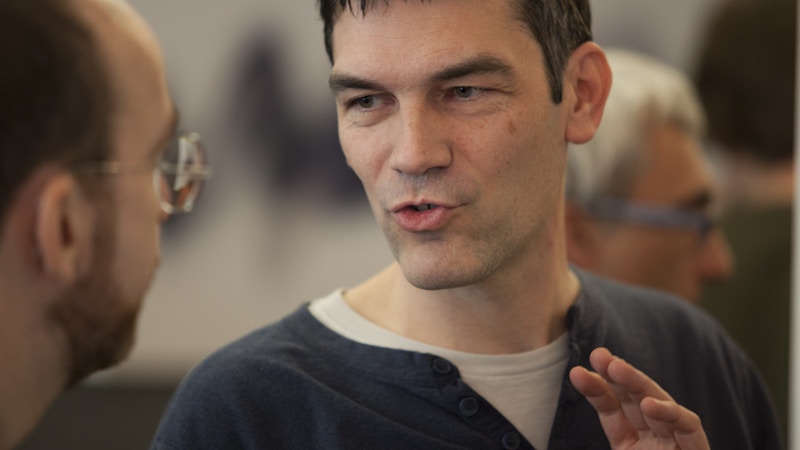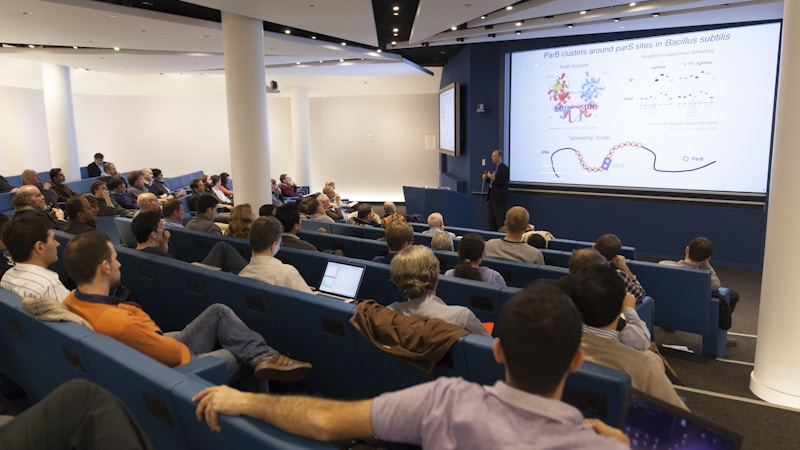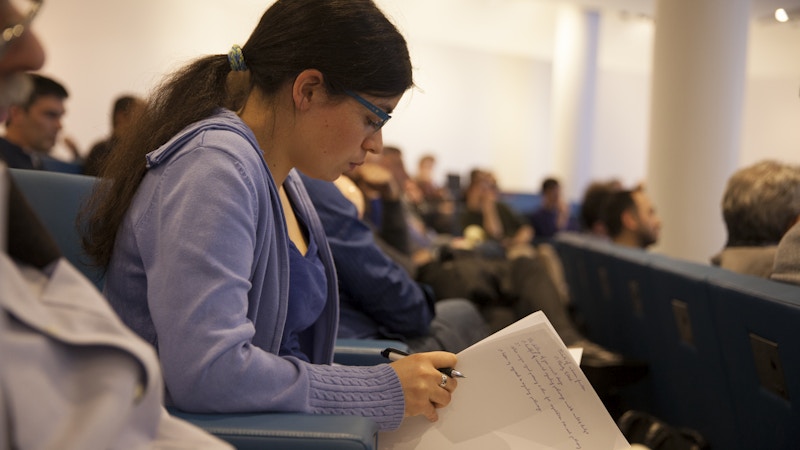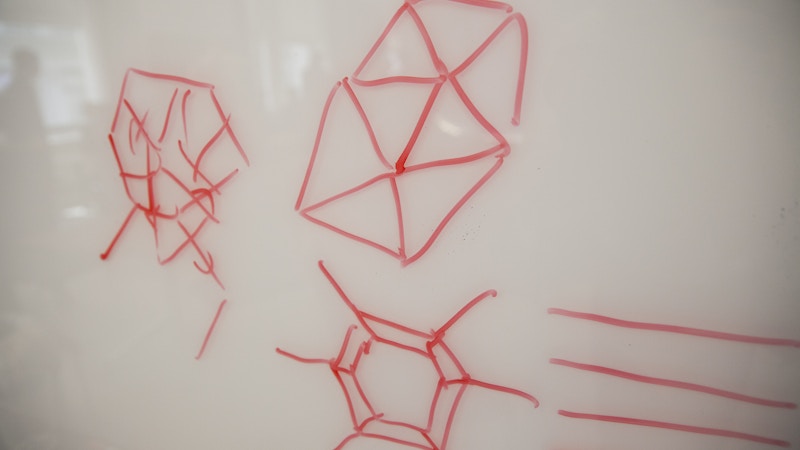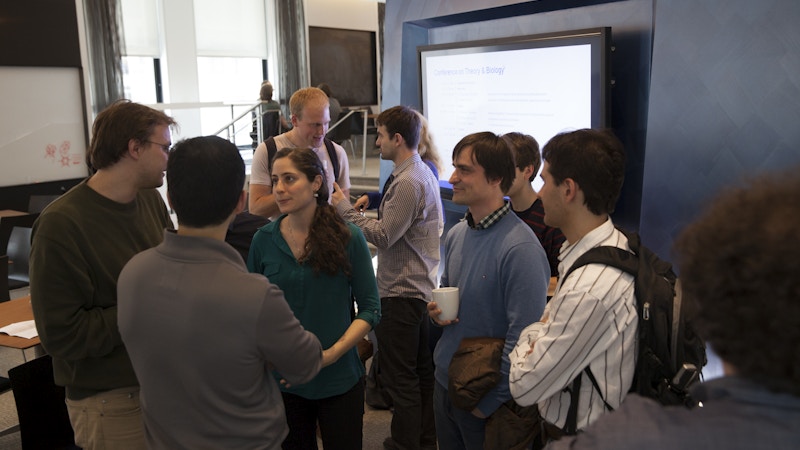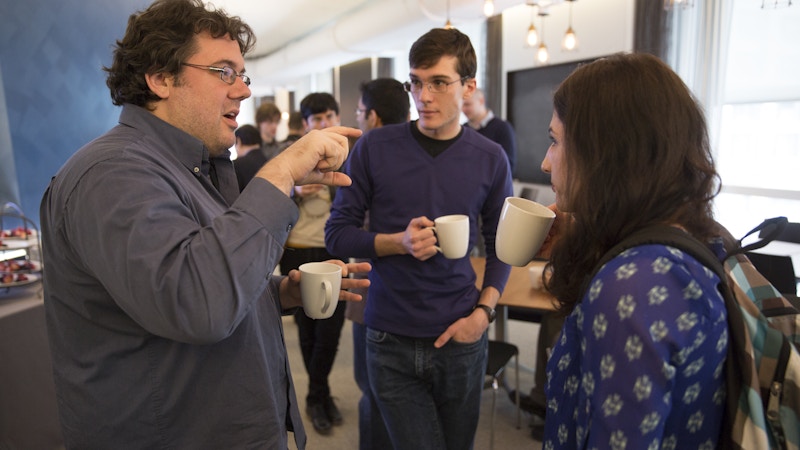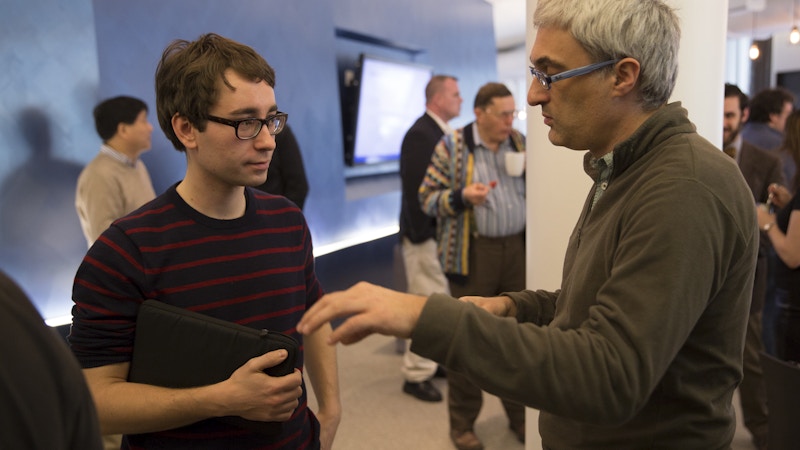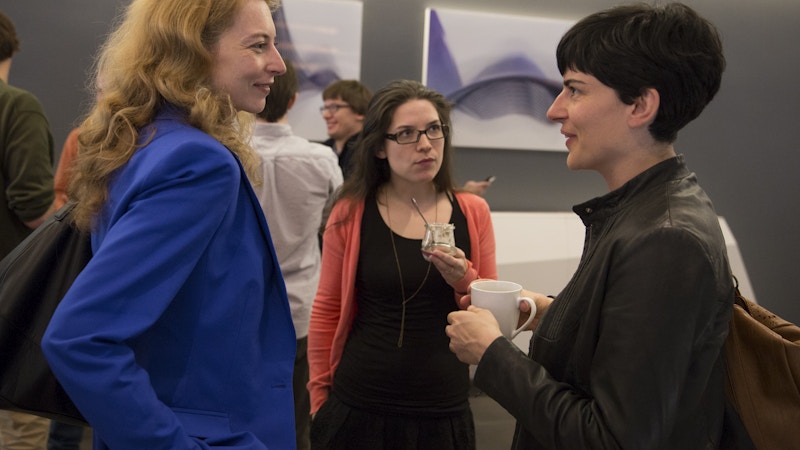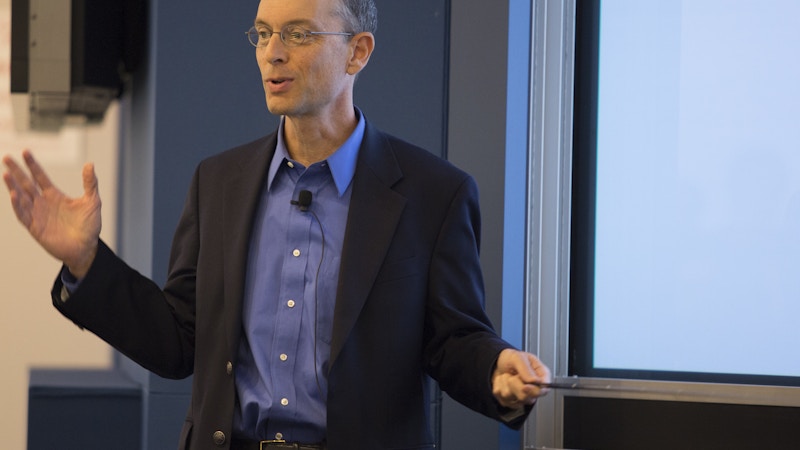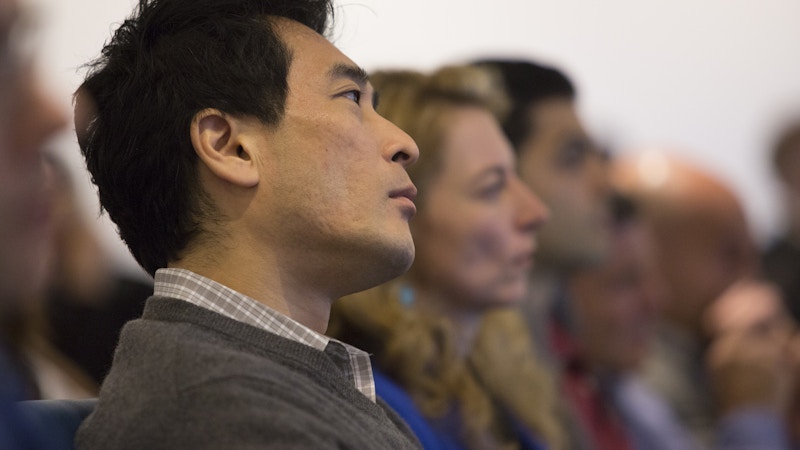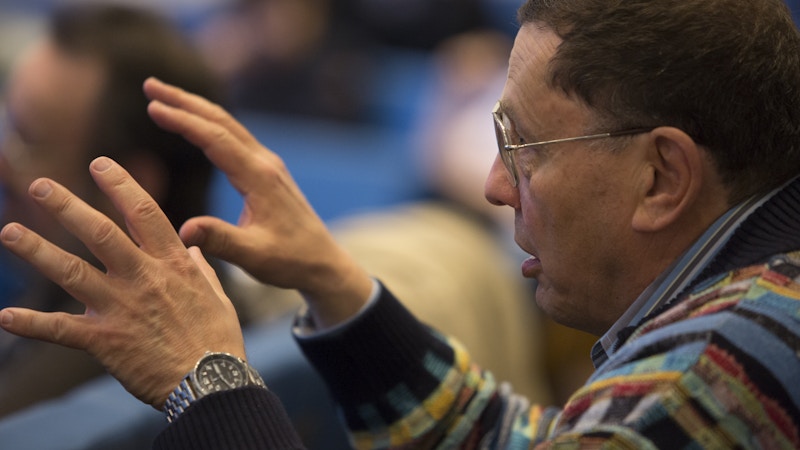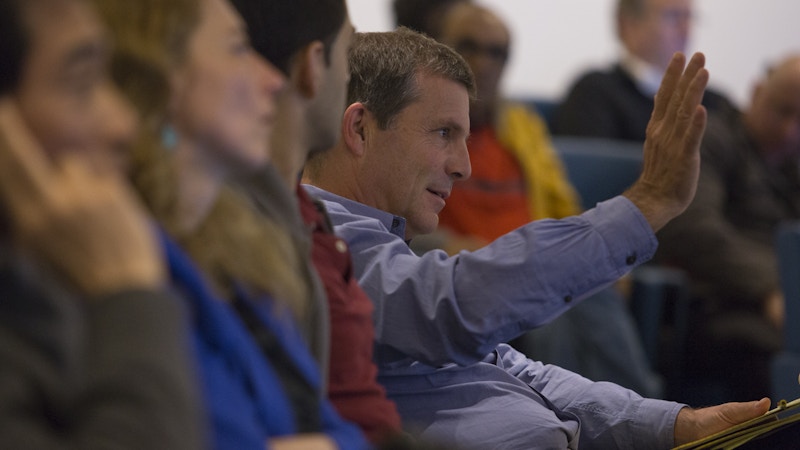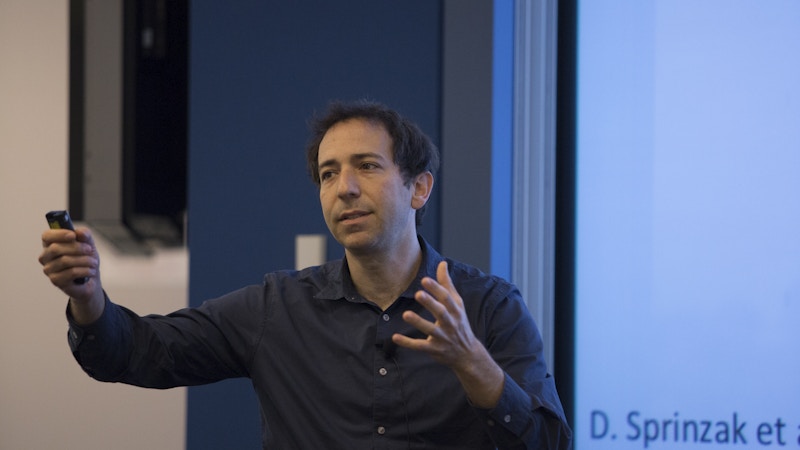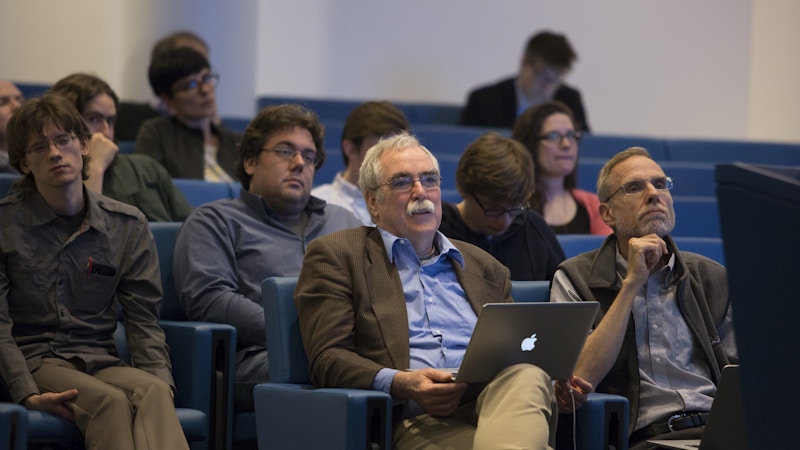2014 Conference on Theory & Biology
On April 11, 2014, the Simons Foundation hosted 132 scientists for a one-day conference on theory and biology. Organized under the aegis of the foundation’s Mathematical Modeling of Living Systems program (a joint initiative of the Mathematics and Physical Sciences and Life Sciences divisions), the conference featured two overview talks on the role of theory in the life sciences, as well as eight talks highlighting interactions between theory and experimentation. Topics ranged from the mechanics of cell-shape change during Drosophila embryonic development to ideas for understanding the representation of smells by networks of neurons in mammals.
The conference was organized to highlight the roles played by theoretical work in the life sciences, from the modeling of current experimental data to the formulation of concepts that help scientists organize results and plan new experiments. “We have the data now, and so the great curiosity in a group like this is if it’s possible to use the data in a way that brings the level of understanding higher than it was before,” says Eric Wieschaus, a professor of molecular biology at Princeton University.
The event brought together both theoretically and experimentally oriented scientists, providing them with an opportunity to share ideas and learn from one another. “There was a lot of time for informal interactions and conversations, and that’s important,” says Harmen Bussemaker, an associate professor of systems biology at Columbia University.
The Conference on Theory and Biology will be held annually at the Simons Foundation in New York City.
Talks
By clicking to watch this video, you agree to our privacy policy.
Mechanics of cell shape change during Drosophila gastrulation
Eric Wieschaus, Princeton University
How cells convert patterns of gene activity into the physical properties that control shape and motility is a major question in biology. In Dr. Wieschaus’s talk, he described recent experiments that address these questions using the Drosophila embryo as a model system. Cells in the ventral region of this embryo are assigned to the mesodermal cell fate by two transcription factors, Twist and Snail. These cell fates’ decisions are followed by immediate changes in cell shape that internalize the mesoderm. He has characterized this reorganization using computational tools that allow tracking physical properties of all 800 mesodermal cells during gastrulation. His experiments show that cell shape changes and nuclear position is driven by pulses of actin-myosin constriction in the apical surface that are somehow transmitted across the entire length of the cell by the non-compressible nature of the cytoplasm.
Surprisingly, many of the morphological changes in mesodermal cells still occur in mutants in which cellularization has been blocked. He investigated the properties of the cytoplasm that transmit force in the absence of membrane by tracking fluorescent beads in living embryos, and by locally disrupting the cytoskeleton using laser dissections.
These various experiments have led to two different approaches for modeling cell shape change and morphogenesis during gastrulation. In one approach, he used a computational vertex model, where passive volume maintenance in cells bounded by an elastic cellular membrane can account for invagination of the furrow. The second approach eliminated the role of elastic cell membranes and relied on the Navier-Stokes equation to explain the invagination in terms of global flows in viscous cytoplasmic medium. He presented genetic data and morphological observations to distinguish between the two models.
This presentation was made in collaboration with Bing He, Konstantin Doubrovinski, Oleg Polyakov and Joshua Shaevitz.
By clicking to watch this video, you agree to our privacy policy.
Keeping it together: Organizing the bacterial chromosome for division
Ned S. Wingreen, Princeton University
Research has shown the bacterial chromosome to be highly organized in space in many bacteria, although the origins of this organization remain unclear. Chromosomal organization is further complicated by the requirement for replication and segregation. In a variety of bacteria, partitioning proteins of the ParABS system mediate chromosome and plasmid segregation. At its heart, this segregation machinery includes a large ParB–DNA complex consisting of hundreds of ParB proteins. The nature of interactions between DNA-bound ParB proteins and how these determine the structural properties of the partitioning module remains unclear. In particular, does ParB spread along the DNA to form a filamentous protein-DNA complex with a 1D character, or rather does it assemble to form a 3D complex on the DNA? And how does the presence of only one or even a few parS sites lead to robust formation and localization on the chromosome of such a large protein-DNA complex? Dr. Wingreen presented a simple model for interacting proteins on DNA, which reveals that a combination of 1D spreading bonds and a 3D bridging bond between ParB proteins constitutes a minimal model for condensation of a 3D ParB-DNA complex. These combined interactions provide an effective surface tension that prevents fragmentation of the ParB–DNA complex. Importantly, this model accounts for recent experiments on ParB-induced gene silencing and the effect of a DNA “roadblock” on ParB localization. Furthermore, the model provides a simple mechanism to explain how a single parS site is both necessary and sufficient for the formation and localization of the ParB–DNA complex.
By clicking to watch this video, you agree to our privacy policy.
Adaptation in bacterial chemotaxis
Massimo Vergassola, University of California, San Diego
The response of E. coli to the chemoattractant aspartate features perfect adaptation, i.e., constant stimuli are filtered out, whilst the response to the chemoattractant serine does not. Adaptation (perfect or partial) is common to many cellular and neurobiological sensory systems.
Bacterial chemotaxis has the notable advantage of being well characterized at the molecular level, making it both appropriate and timely to address the functional and selective aspects of its dynamic and adaptation properties. Dr. Vergassola discussed this issue, presenting past and ongoing theoretical and experimental work.
By clicking to watch this video, you agree to our privacy policy.
Circuits of unknown function
Michael B. Elowitz, California institute of Technology; Investigator, HHMI
Cells use circuits of interacting genes and proteins to control their behaviors, but the design principles that govern genetic circuit architecture usually remain mysterious. Dr. Elowitz’s lab seeks to identify and understand such design principles. To do so, he and his lab combine three synergistic approaches: First, they apply time-lapse movies and quantitative image analysis to follow the dynamics of genetic circuits in individual cells. Second, they develop synthetic biology approaches in which they design and construct new genetic circuits (or rewire natural ones) to implement specific functions in cells. Finally, they use mathematical models to explore the dynamics of actual and potential genetic circuit architectures. They work with bacteria, yeast and mammalian cells, model systems that enable the precise genetic manipulation and measurement of the dynamics of cellular gene circuits. In this talk, Dr. Elowitz discussed recent work from bacteria to mammalian cells in which careful analysis of gene circuit dynamics is beginning to shed light on the design principles of core cellular circuits.
By clicking to watch this video, you agree to our privacy policy.
What the mouse glomerulus tells the mouse brain
Dmitry Rinberg, New York University Neuroscience Institute
The basic questions of sensory coding are: (1) How is information about the stimulus encoded by activity of the neurons, and (2) what features of this activity can be read by the higher brain areas? We use psychophysics, electrophysiology and optogenetics to approach these questions in mouse olfaction, which is arguably the most genetically tractable and highly relevant sensory system for rodent behavior. The segregation of each of the 1000+ olfactory receptor neuron types into its respective olfactory bulb glomerulus implies that 1000+ chemical features are initially encoded separately. What is the role of these individual channels of information transmission in olfactory perception, and what specific features of olfactory stimuli do these channels transmit from the bulb to the higher brain areas? Electrophysiological recording of the activity of second order neurons, which take their input from the glomeruli, establishes that the timing of their activation carries information about odor identity and concentration. Behavioral experiments with the optogenetic stimulation of an individual glomerulus demonstrate that this timing can be read by the brain.
By clicking to watch this video, you agree to our privacy policy.
Deciphering the olfactory code
Alexei Koulakov, Cold Spring Harbor Laboratory
Olfaction is the final frontier of our senses. Unlike vision and hearing, where a relatively straightforward relationship exists between stimulus features and neural responses, the olfactory code remains unbroken. Koulakov described his lab’s recent attempts to understand various features of the representation of smells by networks of neurons in the mammalian olfactory bulb, including the code’s sparsity, fine temporal structure and adaptation to novel stimuli.
By clicking to watch this video, you agree to our privacy policy.
Embedding of environmental probabilities in populations of sensory neurons
Eero Simoncelli, New York University; Investigator, HHMI
The mammalian brain is metabolically expensive and evolutionary pressures have presumably driven it to make productive use of its resources. During early stages of sensory processing, this concept can be expressed more formally as an optimality principle: the brain maximizes encoded information about relevant sensory variables given available resources. Dr. Simoncelli described a specific instantiation of this hypothesis that predicts a direct relationship between the distribution of sensory attributes encountered in the environment, and the selectivity and response levels of neurons within a population that encodes those attributes. This allocation of neural resources, in turn, imposes direct limitations on the organism’s ability to discriminate different values of the encoded attribute. Dr. Simoncelli showed that these physiological and perceptual predictions are borne out in a variety of visual and auditory attributes. Finally, he showed that this encoding of sensory information provides a natural substrate for subsequent computation, which can make use of the knowledge of environmental (prior) distributions that is embedded in the population structure.
By clicking to watch this video, you agree to our privacy policy.
Mechanics of morphogenesis: from theory to experiment and back
Boris Shraiman, Kavli Institute for Theoretical Physics
Morphogenesis involves cell proliferation and rearrangement and has many distinctly mechanical aspects that are part and parcel of the “executable program” of development.
This talk (a) reviewed the experimental status of the idea of mechanical feedback regulation of growth (in an epithelial layer), (b) described how a simple theoretical model of cell mechanics can be used to infer mechanical forces within an epithelial layer and (c) used this inference method alongside live-imaging data and phenomenological modeling to gain some insight into the mechanisms of germ-band extension and ventral furrow formation in Drosophila embryos.
Perspectives on theory and biology
Daniel Fisher, Stanford University

